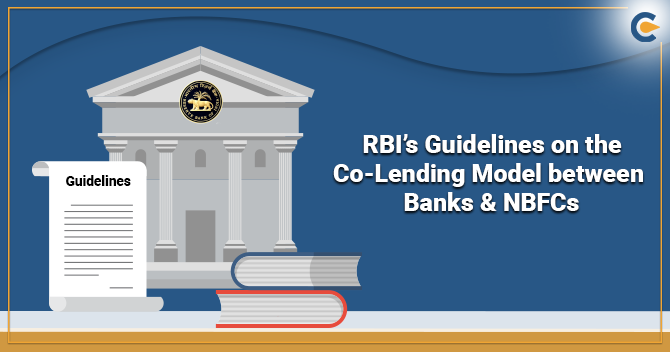The Reserve Bank of India has come up with a Co-Lending Model (CLM) scheme under which the banks together with NBFCs shall provide the loans to the priority sector borrowers on the basis of prior agreement. The Co-Lending Model is an enhancement of the co-origination of loan scheme that was announced by RBI in September 2018. It aims at providing greater flexibility to all the lending institutions. Let’s read more about the RBI’s Guidelines on the Co-Lending Model between Banks & NBFCs.
What is the notification of RBI on Co-Lending Model between Banks & NBFCs?
The notification was passed by RBI RBI/2020-21/63 on 5th November, 2020FIDD.CO.Plan.BC.No.8/04.09.01/2020-21.
The main purpose of this notification is:
- To raise the association between the banks and NBFCs while dealing with the lending areas in the priority sectors.
- To create a proficient harmonisation of loans in few sectors by adopting the strategies of Government.
- To mitigate the crisis caused due to Covid-19 to the banks.
- To facilitate the financial institutions to afford easy credit to the borrowers from the priority sector.
Read our article:NBFC Registration – Know the Entire Incorporation Procedure
Priority Sector
The important priority sectors of the economy as is considered by RBI are the sectors where timely and sufficient credit might not easily reach. The Priority Sector includes the following categories:
- Agriculture
- Housing
- Micro, Small and Medium Enterprises (MSMEs)
- Export Credit
- Education
- Start-ups
- Renewable Energy
- Social Infrastructure
- Miscellaneous
What are the Guidelines of the Co-Lending Model?
The primary objectives of the Co-Lending Model are given as below:


- Improvement of Credit Flow: The government has expressed his proposal to support the rural parts of the India. As the rural sector represents the major proportion of the population in India. Therefore, the objective is to accomplish the flow of impeccable credit in the rural society and help in its growth and development.
- Maximum Reach– The collaboration would make it possible and add the advantages from both the Non-Banking Financial Companies and the Banks. The lower cost of funds from the banks and the greater reach of the NBFC shall together make the low cost funds available to the ultimate beneficiaries.
- Generating Funds: The objective is to generate the availability of more funds especially to the rural areas because affording loans from the public sector and financial institutions is often a difficult task for the people from rural. Therefore, banks have done the collaboration with these Non-Banking Financial Companies to generate funds to the rural area.
- Sharing the risks and returns: Collaboration between banks and NBFCs would not only represent the improvement in lending plans but also the development of latest technologies. However, it shall also consist of distribution of various forms of risks and returns between the Banks and NBFCs which would eventually reduce the burden on them.
- To boost the Relationship: The collaboration shall result in boosting the relationship between Bank and NBFCs and this is the reason government has come up with the scheme of co-lending model. By this scheme, the goals of both the Banks and Non-Banking Financial Companies can together be attained in harmonization. The government has introduced numerous policies to boost the alliance or relationship between the Non-Banking Financial Companies and Bank. The result of collaboration will generate more lending.
What are the Characteristics of the Co-Lending Model?
The Reserve Bank of India has introduced the co-lending scheme to increase and enhance the lending terms between both the Banks and the Non-Banking Financial Companies. The major characteristics of the co-lending model are given below:
- Systems: The banks and the Non-Banking Financial Company (NBFC) have to make sure that there are efficient systems placed to implement the measures on Anti-Money Laundering and Due Diligence.
- Clients: It is the responsibility of the Non-Banking Financial Companies to deal and negotiate with the clients.
- Master Agreement: The master agreement would be the contract entered between the bank and NBFC.
- Warranties and Representations: All agreements with the terms of the co-lending model shall contain the representations and warranties which must be according to the pre-negotiated terms and conditions between Non-Banking Financial Companies and banks.
- Internal Audit: It is important to comply with the internal and external audit guidelines between the banks and NBFC regarding the type of loans that shall be offered under the co-lending scheme.
- Security: The NBFC and bank together shall decide the terms regarding the security creation in the co-lending model.
- Business Continuity: The provisions regarding the co-lending agreement should not have any effect on the regular business which is preserved between the banks and NBFCs with the clients.
- Approval: All the information’s of the co-lending model should mandatorily be disclosed to the clients and must be approved by them. The client can also submit their complaints to the Customer Education and Protection Cell in the Reserve Bank of India.
- Loans Recovery: The co-lending scheme would have the relevant arrangement pertaining to the recovery of the loans from clients.
- Promoter Groups: In this co-lending model, banks are not permitted to enter any other co-lending regime, where the Non-Banking Financial Company has directly managed through a promoter group.
Conclusion
The Reserve Bank of India[1] (RBI) has introduced the Co-lending model scheme by collaborating between the Banks and the NBFCs. Hence, it is important in this agreement that all the terms should be in compliance as has been agreed with the parties so as to fulfill the objective of providing the loans to the priority sector borrowers on the basis of prior agreement.
Read our article:NBFC Registration: Step by Step Procedure











